
* After World War I, pioneering Russian aircraft designer Igor Sikorsky came to the United States, to set up an aircraft company. He had mixed success in his aircraft designs, finally getting on track with a series of flying boats, from the "S-34" to the "VS-44", of generally increasing size and capability. This document provides a history and description of the Sikorsky flying boats -- and also described the limited series of flying boats flown by Boeing. A list of illustration credits is provided at the end.
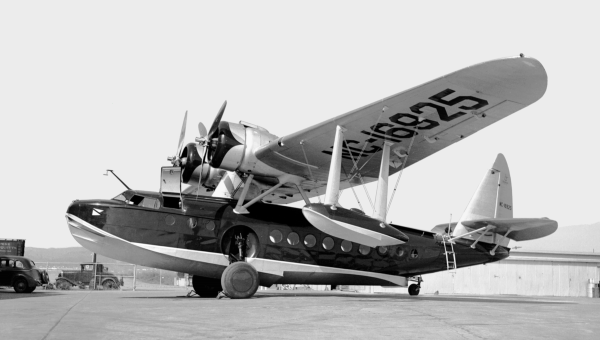
* Igor Ivanovich Sikorsky had been born in Kiev, then in the Russian Empire, in 1889. As a lad, he acquired an engineering degree and got the bug to build flying machines. He experimented with helicopters, which didn't work out, and built a series of airplanes, culminating in 1913 with the flight of the "Russky Vityaz (Russian Knight)", the world's first flyable four-engine aircraft.
Skeptics had doubted that anyone could build an aircraft that big, the belief being that birds didn't get really big -- but that was really only true for ornithopers, flapping-wing machines. Sikorsky proved them wrong; with aircraft, the big questions were wing loading and power-to-weight ratio. From 1913 to 1917, he built at least 60 "Ilya Muromets" four-engine bombers / airliners, which served with the Tsar's forces.
Sikorsky left Russia after the 1917 Revolution, to go to France and then, in 1919, to New York City. He arrived penniless, but he was smart, energetic, and enterprising. By 1924, he had established the Sikorsky Aero Engineering Corporation on Long Island, where he built his first American aircraft, the "S-29-A" airliner -- with the "A" not indicating a model, but its American origin. Some of the funding was provided by Sergei Rachmaninoff, the expatriate Russian composer.
The S-29-A was, by the standards of the time, a big aircraft, being a biplane -- or more properly a "sesquiplane", meaning "one & a half wings", the bottom wing being substantially shorter than the top wing. It was powered by twin vee-12 water-cooled Liberty L-12 engines providing 300 kW (400 HP) each, and driving fixed-pitch two-blade wooden propellers. The S-29-A had a steel fuselage, with strut-braced wings made of wood and fabric, plus fixed taildragger landing gear. It had a length of 15.19 meters (49 feet 8 inches), a wingspan of 21.04 meters (69 feet), an empty weight of 3,635 kilograms (8,015 pounds), and a passenger capacity of 14 seats. It cruised at 160 KPH (100 MPH).
The single S-29-A was used for demonstration flights -- Sikorsky often being the pilot -- and for passenger service, but airlines didn't want to buy it. It was sold off, to be used in a number of different roles, finally being lost in a fatal crash while serving as a movie prop in 1929. Incidentally, it appears that deadly aircraft accidents were not rare in movie productions in that era.
* A twin-engine "S-30" airliner was contemplated, but not built. The next three Sikorsky aircraft were single-engine biplanes, including the "S-31" and "S-32" -- with one each built -- and the "S-33" -- with two built. Sikorsky never built any more single-engine fixed-wing aircraft.
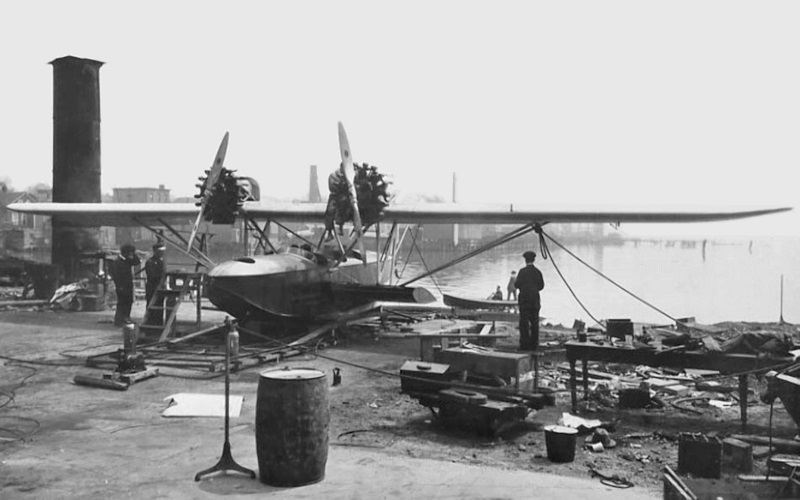
Following the S-33, Sikorsky decided to build a seaplane, developing the "S-34" flying boat, which apparently performed its first flight in 1926. It was also a sesquiplane, with twin 9-cylinder air-cooled Wright Whirlwind J-4 radial engines providing 150 kW (200 HP) each, driving a two-blade fixed-pitch wooden propeller. It had twin taifins, the tail assembly being mounted on a boom that extended from the top wing, which kept the tail out of the water. It could carry five passengers. Wingspan was 17.07 meters (56 feet), length was 10.36 meters (34 feet), and empty weight was 1,315 kilograms (2,900 pounds). During a test flight on 31 May 1927, it developed engine trouble, and was lost in a forced landing in Long Island Sound. Sikorsky and the others on board escaped unharmed.
* That wasn't the only trouble Sikorsky had been having at the time. In support of an attempt at a non-stop trans-Atlantic cross, to be flown by French Ace Rene Fonck, Sikorsky decided to build another twin-engine sesquiplane, the "S-35". Fonck suggested a third engine; it was duly added, with the S-35 performing its initial flight on 23 August 1926.
The S-35 had a length of 13.41 meters (44 feet), an upper wingspan of 30.78 meters (101 feet), and an empty weight of 4,400 kilograms (9,700 pounds). It was powered by three Bristol Jupiter 9A nine-cylinder air-cooled radial engines, built under license by Gnome-Rhone, providing 315 kW (415 HP) each and driving two-blade wooden fixed-pitch props. Unfortunately, when the S-35 took off on a trans-Atlantic flight attempt on 21 September 1926, its landing gear disintegrated during take off; the aircraft went into a ditch and caught on fire. Fonck and the co-pilot escaped, but the other two crew were killed.
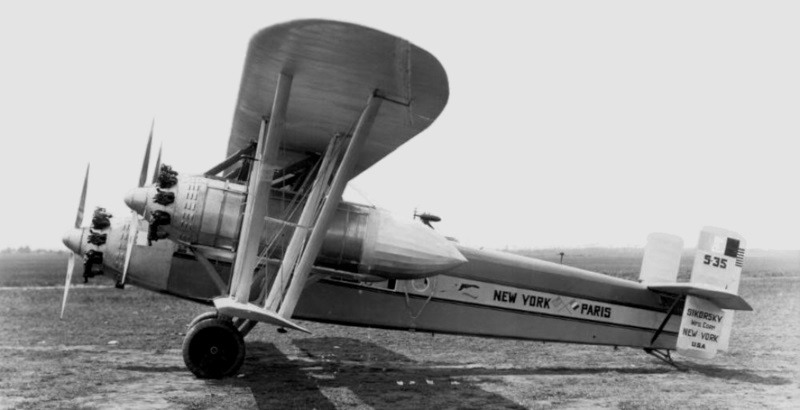
Sikorsky went back to the S-34 design and improved on it, resulting in the "S-36". It had the same general configuration, but differed in having an enclosed cabin and in having the two Wright J-5 Whirlwind radial engines mounted below, not on top of the wing. Unlike the S-34, the S-36 was an amphibian, with pull-up main landing gear alongside the boat hull and a tailskid. It had a crew of two and seats for six passengers, on facing bench seats.
___________________________________________________________________
SIKORSKY S-36:
___________________________________________________________________
wingspan:
18.9 meters (62 feet)
wing area:
54.35 sq_meters (585 sq_feet)
length:
10.36 meters (34 feet)
height:
3.66 meters (12 feet)
empty weight:
1,792 kilograms (3,950 pounds)
operating weight:
2,722 kilograms (6,000 pounds)
max speed:
195 KPH (100 MPH / 175 KT)
service ceiling:
4,570 meters (15,000 feet)
___________________________________________________________________
Six were built, one being obtained by the US Navy as the "XPS-1", fitted with a machine gun in the nose. It was evaluated as a patrol aircraft but was actually used as a transport. One S-36 was sold to Mrs. Frances Grayson, a wealthy divorcee, who wanted to the first woman to fly across the Atlantic -- as a passenger. The aircraft, named DAWN, took off on 23 December 1927 into foul weather and then disappeared, with an extensive search turning up nothing. A message found in a bottle a month later indicated that the DAWN had lost fuel and been forced down off Grand Banks. More significantly, one was obtained by Pan American Airlines. None have survived.
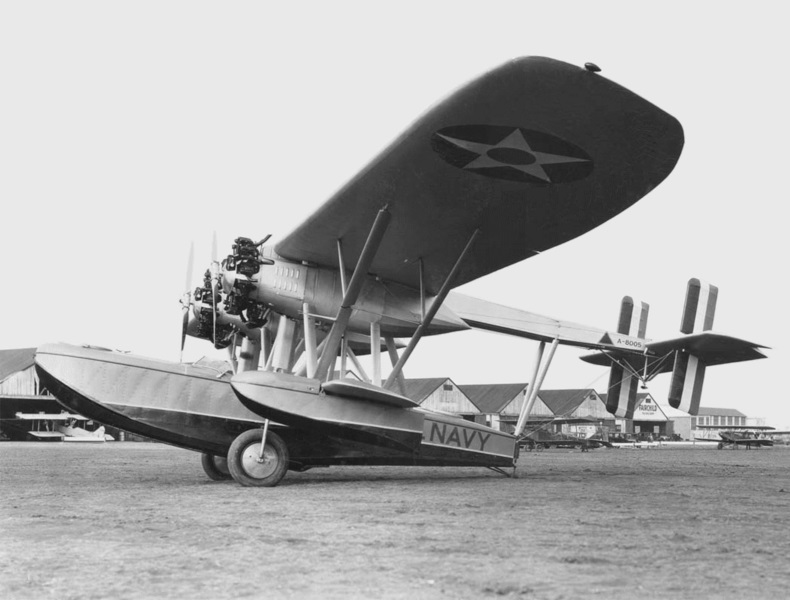
* In the meantime, Sikorsky had been working with Fonck on another attempt at a trans-Atlantic crossing -- coming up with yet another twin sesquiplane, the "S-37". However, Charles Lindbergh ended up performing the first non-stop trans-Atlantic flight in May 1927, and the race was over. The S-37 was accordingly completed as a land-based airliner.
The upper wingspan was 30 meters (100 feet), while the length was 13.87 meters (45 feet 6 inches), and the empty weight was 3,630 kilograms (8,000 pounds). It was originally to be powered by twin Jupiter 9A radials, but the powerplants ended up being Pratt & Whitney (PW) 9-cylinder air-cooled Hornet radials with 390 kW (525 HP) each.
The first S-37 built was sold off to American International Airways of Argentina, to be later acquired by Pan Am, and ultimately scrapped. A second, improved "S-37-2", later known as the "VS-37B", built in partnership with Consolidated, was evaluated by the Army Air Corps as a bomber, but rejected. It was modified to airliner configuration and changed hands several times, finally being equipped with floats and used for a round-the-world flight attempt -- with the VS-37B being lost in the Atlantic. All further Sikorsky fixed-wing aircraft would be flying boats.
BACK_TO_TOP* Following the S-36 flying boat, Sikorsky went on to develop a scaled-up and improved derivative, the "S-38", with its initial flight on 25 May 1928. It had much the same configuration as the S-36, but featured an enclosed cockpit and cabin, twin tailbooms instead of one, and a tailwheel instead of a skid. The S-38 was powered by twin PW R-1340 Wasp 9-cylinder air-cooled radial piston engine with 310 kW (420 hp) each, driving 2-bladed ground-adjustable metal propellers. It had a crew of two and could, initially, carry eight passengers, or 2,030 kilograms (4,480 pounds) of cargo.
___________________________________________________________________
SIKORSKY S-38:
___________________________________________________________________
wingspan (top):
21.84 meters (71 feet 8 inches)
wingspan (bottom):
10.97 meters (36 feet)
wing area (total):
67 sq_meters (720 sq_feet)
length:
12.32 meters (40 feet 5 inches)
height:
4.22 meters (13 feet 10 inches)
empty weight:
2,970 kilograms (6,548 pounds)
MTO weight:
4,753 kilograms (10,479 pounds)
max speed:
200 KPH (125 MPH / 110 KT)
service ceiling:
5,500 meters (18,000 feet
range:
970 kilometers (600 miles / 520 NMI)
___________________________________________________________________
The S-38 proved successful, in large part because of the Foreign Airmail Act of 1928. Pan Am used it to pioneer airmail routes in the Caribbean, with Charles Lindberg flying it for Pan Am to validate the routes. It appears Howard Hughes flew one as well.
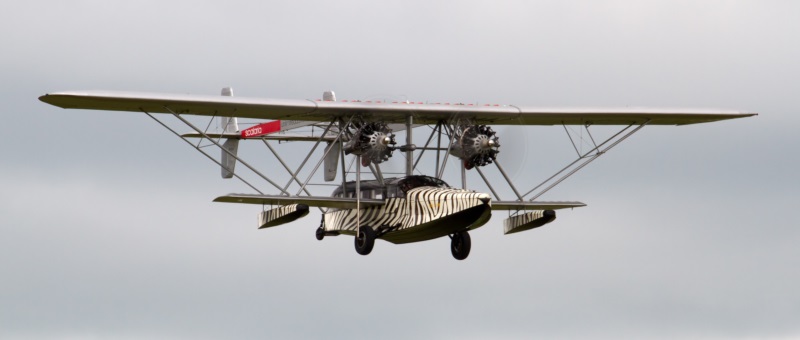
A total of 101 S-38s was built, these aircraft being made at the Sikorsky plant on Long Island, with more production then taking place at a second Sikorsky factory in Bridgeport, Connecticut. The Sikorsky company was bought up by the United Aircraft & Transport Corporation while the S-38 was being produced. Manufacture included 11 8-passenger "S-38A" flying boats, followed by 80 10-passenger "S-38B", and finally 10 12-passenger "S-38C" flying boats. Some of the production ended up in US military hands:
One S-38 was flown by the Spanish Republicans during the Spanish Civil War, to be shot down by friendly fire. Two replicas of the S-38 were built in 1990, with one of them still flying at last notice. The replicas were painted in zebra stripes -- in honor of Martin and Osa Johnson, husband and wife film-makers. They flew an S-38 named OSA'S ARK with such a paint scheme as they toured Africa, turning out popular safari movies and books.
* The good sales of the S-38 convinced Sikorsky there was a niche for a smaller and cheaper derivative, the result being the "S-39", with the first flight on 24 December 1929. It had much the same configuration as the S-38, but only one engine -- a PW R-985 Wasp Junior 9-cylinder air-cooled radial engine providing 220 kW (300 HP), driving a two-bladed prop -- and no lower wing, with the floats mounted on underwing bracing.
The S-39 had a wingspan of 15.85 meters (52 feet), a length of 9.73 meters (31 feet 11 inches), and an empty weight of 1,215 kilograms (2,680 pounds). It could carry about 550 kilograms (1,210 pounds) of cargo. At least 23 were built, including the "S-39A", with four seats, and the "S-39B", with five seats. Sources also mention an "S-39C", it seems a conversion from an S-39B, but details are lacking. One was flown by the Army Air Corps as the "C-28".
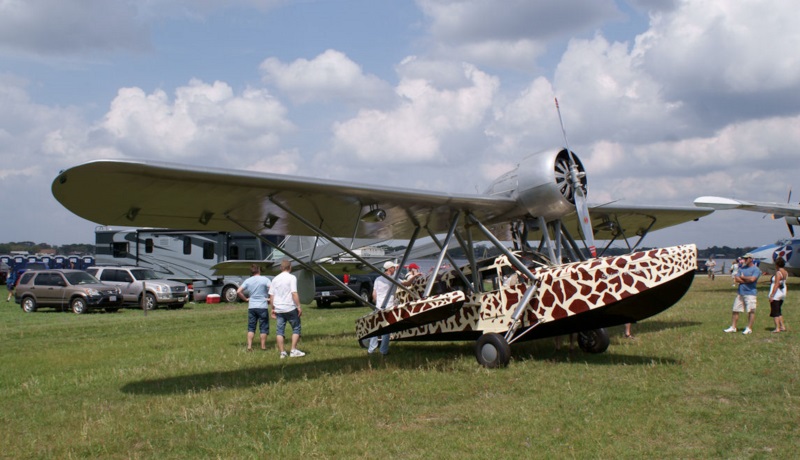
One refurbished S-39 was still flying at last notice -- this machine being painted in giraffe spots, in honor of an S-39 flown by the Johnsons and named SPIRIT OF AFRICA. It appears the Johnsons were prominent public figures in their time; Martin was killed in an airliner wreck in 1937 and Osa was crippled, though she did her best to carry on the family business. Today, they are largely forgotten, making the paint jobs of the flying S-38 and S-39 something of a puzzle to those who don't know the story.
* Having scaled down the S-38 into the S-39, Sikorsky decided to scale it up, with the "S-41" performing its first flight in 1930. It was more a scaled-up S-39, with no lower wing, and able to seat 15 passengers. It had a wingspan of 24 meters (78 feet 9 inches), a length of 13.77 meters (45 feet 2 inches), and an empty weight of 3,675 kilograms (8,100 pounds). It was powered by twin R-1860 Hornet radials, in ring cowlings, with 430 kW (575 HP) each and driving two-bladed metal props.
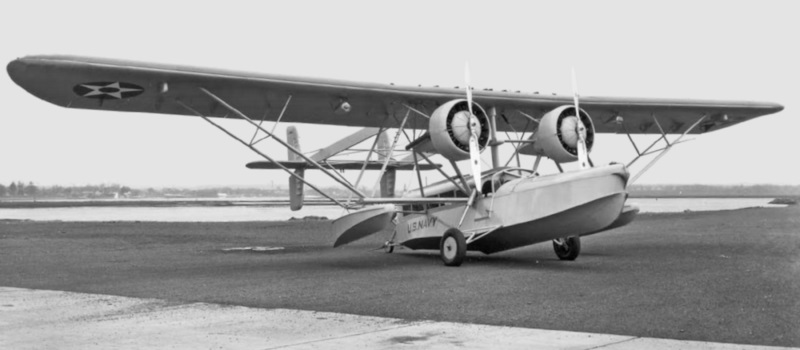
Only seven were built, in "S-41A", "S-41B", and "S-41C" versions, with three obtained by the US Navy under the designation of "RS-1". It seems the other four were obtained by Pan Am, with two of them later impressed into Navy service as the "RS-5".
BACK_TO_TOP* The "S-40" designation, skipped over above, was for a much more ambitious flying boat project -- a four-engine aircraft, designed in response to a request from Juan Trippe, boss of Pan Am. Initial flight of the S-40 was on 7 August 1931. It was broadly of the same configuration as the S-39 and S-41, with no lower wing, a parasol-mounted upper wing with underslung engines, and a twin-boom tail. Wingspan was 34.75 meters (114 feet), length was 23.16 meters (76 feet), and empty weight was 10,435 kilograms (23,000 pounds). It was powered by four R-1860 Hornet B radials in ring cowlings, with 430 kW (575 HP) each and driving two-bladed metal props. It was capable of hauling 38 passengers over a range of 1,450 kilometers (900 miles).
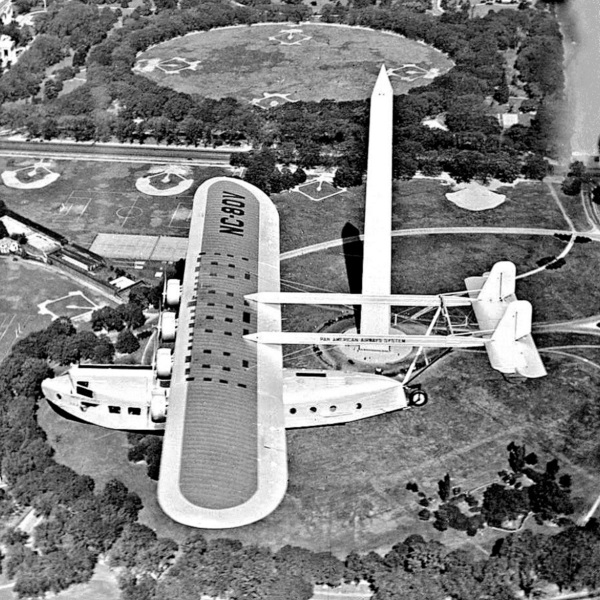
It was equipped as a flying luxury liner, featuring a pantry with an electric refrigerator and stove, as well as a smoking lounge with mahogany wood paneling. Six life rafts were carried. It was something of a dream come true for Sikorsky, who wrote in his autobiography:
BEGIN_QUOTE:
... at the age of about 11 years, I had a wonderful dream ... I saw myself walking along a narrow, luxuriously decorated passageway. On both sides were walnut doors, similar to the state room doors of a steamer. The floor was covered with an attractive carpet. A spherical electric light from the ceiling produced a pleasant bluish illumination. Walking slowly, I felt a slight vibration under my feet and was not surprised to find that the feeling was different from that experienced on a steamer or on a railroad train. I took this for granted because in my dream I knew that I was on board a large flying ship in the air.
END_QUOTE
In the air with the S-40, Sikorsky recalled the dream, and how it had become reality. Only three S-40s were built, being flown by Pan Am as "Clippers", which would become the default name of the big American commercial flying boats of that era. In 1935, the three S-40s were updated, to be redesignated "S-40A". The upgrade involved replacing the Hornet B radials with supercharged R-1690 Hornet T2D1 radials with 490 kW (660 HP) each, and increasing the maximum weight. The landing gear was also removed, the aircraft being too heavy to land on an airstrip -- though it may have been removed after the original introduction.
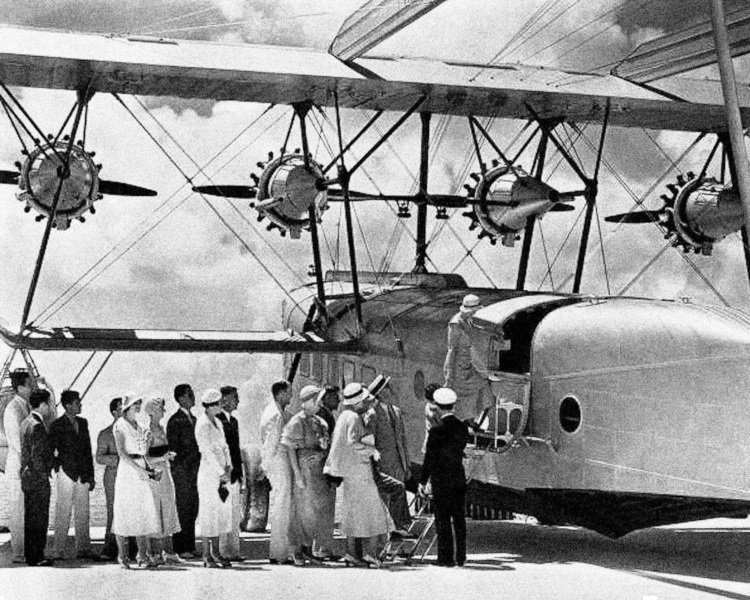
The S-40 was a very cluttered aircraft, with so many struts and braces that Charles Lindbergh called it a "flying forest". Sikorsky knew it was stodgy but realized that coming up with something better was going to take time, and wanted to get the S-40 in the air quickly. The three S-40 Clippers flew without incident up to 1940, when they were impressed into Navy service under the designation of "RS-4". The Navy flew them as trainers for four-engine flying boats, and then scrapped them from 1943.
* The result of the rethink of the S-40 design was the much-improved four-engine "S-42". The first S-42 performed its initial flight on 29 March 1934. It was a cleaner aircraft, with a strut-braced wing on a pedestal; a braced tailplane mounted on top of the rear of the fuselage, with twin tailfins; engines mounted on the front of the wing; and wing flaps. It had a crew of four and could carry 37 passengers, or be fitted with 14 sleeper berths. It was a pure flying boat, with no landing gear.
___________________________________________________________________
SIKORSKY S-42:
___________________________________________________________________
wingspan:
34.8 meters (114 feet 2 inches)
wing area:
124 sq_meters (1,330 sq_feet)
length:
20.62 meters (67 feet 8 inches)
height:
5.28 meters (17 feet 4 inches)
empty weight:
8,965 kilograms (19,765 pounds)
operating weight:
17,235 kilograms (38,000 pounds)
max speed:
295 KPH (180 MPH / 160 KT)
cruise speed:
260 KPH (160 MPH / 140 KT)
service ceiling:
4,790 meters (15,700 feet)
range:
1,900 kilometers (1,200 miles / 1,000 NMI)
___________________________________________________________________
Ten S-42s were built, all obtained by Pan Am, in three versions:
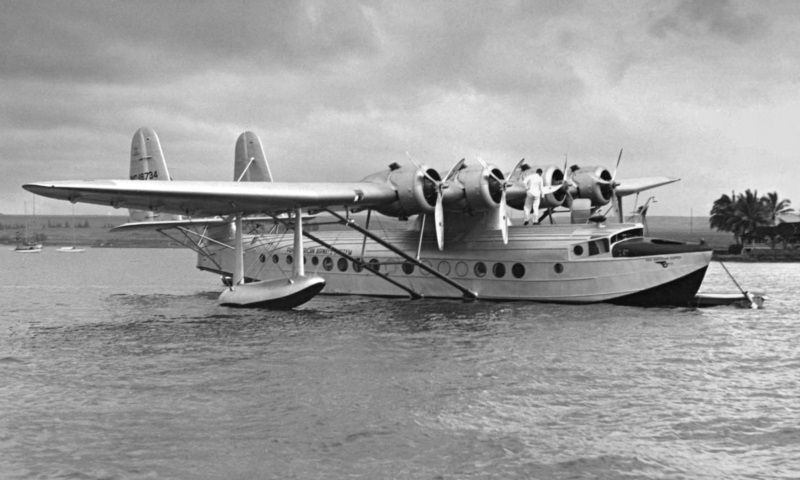
There were discussions on license production in the UK by British Marine Aircraft LTD, but it didn't happen, with the company sold off to become Folland Aircraft LTD. Pan Am primarily flew the S-42 on the Miami to Rio de Janeiro route, with some operations between New York and Bermuda, Manila and Hong Kong, plus Seattle and Alaska. It was also used for pioneering oceanic flight routes for Pan Am, being crammed with fuel tanks instead of passengers. The hazards of being a "flying fuel tank" were demonstrated in 1938, when the S-42 SAMOAN CLIPPER exploded while surveying the Samoan Islands, with all hands lost. The US Navy impressed one in 1942 for transport service. No S-42s have survived, all being either lost in accidents or scrapped.
* Along with the Clipper, Sikorsky developed a scaled-down twin-engine version, the "S-43 Baby Clipper", with initial flight in 1935. It had much the same configuration, other than two engines instead of four -- R-1690-52 Hornet radials with 560 kW (750 HP) each, driving three-bladed Hamilton Standard variable-pitch props -- and was an amphibian, with neatly retracting landing gear. It could carry from 18 to 25 passengers.
___________________________________________________________________
SIKORSKY S-43:
___________________________________________________________________
wingspan:
34.8 meters (114 feet 2 inches)
wing area:
124 sq_meters (1,330 sq_feet)
length:
20.62 meters (67 feet 8 inches)
height:
5.28 meters (17 feet 4 inches)
empty weight:
8,965 kilograms (19,765 pounds)
operating weight:
17,235 kilograms (38,000 pounds)
max speed:
295 KPH (180 MPH / 160 KT)
cruise speed:
260 KPH (160 MPH / 140 KT)
service ceiling:
4,790 meters (15,700 feet)
range:
1,900 kilometers (1,200 miles / 1,000 NMI)
___________________________________________________________________
53 were built, including a number of "S-43B" machines with twin tailfins instead of one. Pan Am obtained a dozen of them, primarily for flights around the Caribbean and to destinations in South America. Other users including Inter-Island / Hawaiian Airlines, Panair do Brasil, Aeromaritime of France, and by others in ones or twos. A few were owned by wealthy individuals as "air yachts", Howard Hughes being one of them.
Five machines were obtained by the Army Air Corps in 1937 as the "OA-8", and used for transport duties. The biggest buyer was the US Navy, which obtained 17 from 1937 to 1939 as the "JRS-1", two being flown by the US Marines. The Chilean Air Force obtained two in 1936, being used to pioneer airline routes.
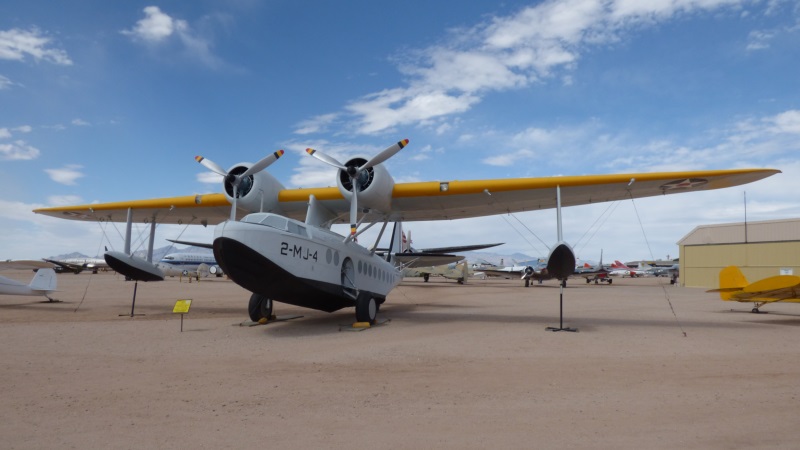
Three S-43s have survived, including one at the Smithsonian National Air & Space Museum's Steven F. Udvar-Hazy Center in Virginia -- this being a JRS-1 that survived the attack on Pearl Harbor. A second is at the Pima Air Museum near Tucson AZ, while the S-43 owned by Howard Hughes is still in flying condition, having been obtained by collector Kermit Weeks.
BACK_TO_TOP* The end game of Sikorsky's flying boats was the "Vought-Sikorsky VS-44", Vought being a sibling component of United Aircraft. It began life in 1935 as a patrol aircraft offered for a US Navy requirement, designated the "XPBS-1". Initial flight was on 9 September 1937; the Navy, after testing, decided to instead acquire the Consolidated XPB2Y-1 -- of similar general configuration, known as the "Coronado". The XPBS-1 remained in US Navy service as a transport, being finally lost on 30 June 1942 after hitting a submerged log -- a deadly enemy of the flying boat. One crewman was killed, while Admiral Chester Nimitz, commander of Central Pacific forces, was slightly injured.
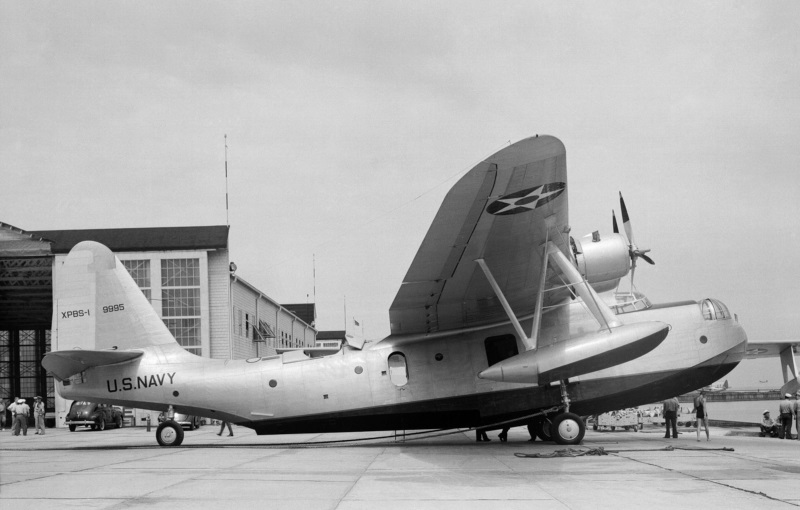
Sikorsky didn't decide to follow up on the XPBS-1 until 1940, then coming up the refined "VS-44" -- where "VS" stood for "Vought Sikorsky". It had the same general configuration as the S-42, being a high-wing flying boat with four engines, but cleaner in configuration, with no wing or tailplane bracing. It was powered by four PW R-1830-S1C3-G Twin Wasp 14-cylinder two-row air-cooled radial engines with 890 kW (1,200 HP) each, driving 3-bladed variable-pitch propellers. The VS-44 could carry 24 to 47 passengers, depending on whether it was configured with berths.
___________________________________________________________________
VOUGHT-SIKORSKY VS-44:
___________________________________________________________________
wingspan:
37.8 meters (124 feet)
wing area:
155 sq_meters (1,670 sq_feet)
length:
24.16 meters (79 feet 3 inches)
height:
5.28 meters (17 feet 4 inches)
empty weight:
11,980 kilograms (26,405 pounds)
operating weight:
22,015 kilograms (48,540 pounds)
max take-off weight:
26,080 kilograms (57,500 pounds)
max speed:
340 KPH (210 MPH / 180 KT)
cruise speed:
280 KPH (175 MPH / 150 KT)
service ceiling:
5,790 meters (19,000 feet)
range:
5,790 kilometers (3,600 miles / 3,125 NMI)
___________________________________________________________________
However, the VS-44 was a latecomer to the trans-oceanic flying boat game -- being overshadowed by the "Boeing 314 Clipper", which would be the most famous of all the Clippers, with more said about it later. In any case, only three VS-44s were built -- being obtained by American Export Airlines (AEA), these machines being named EXCALIBUR, EXCAMBRIAN, and EXETER -- they were derived from the names of passenger liners of American Export Lines, AEA's parent company. The passenger liners were known as "Four Aces", and so the VS-44s became "Flying Aces". They featured full-length beds, dressing rooms, full galley, snack bar, and lounge.
With the arrival of World War 2, the Flying Aces were put under contract by the US Navy, to be designated "JR2S-1", carrying passengers and cargo between New York and Ireland. EXCALIBUR was lost on take-off in Newfoundland in 1942, with 11 of the 37 on board killed. There was talk of license construction of more VS-44s by Nash-Kelvinator with the designation of "JRK-1", but it didn't happen.
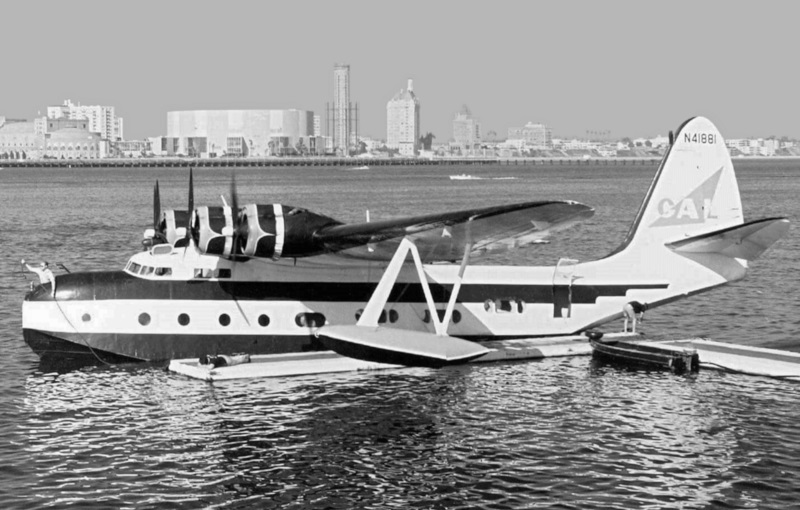
After the war, the two surviving VS-44s continued to fly for AEA, which had been renamed American Overseas Airlines (AOA). In 1946, EXETER was sold to an Uruguayan operator -- to be lost in a crash in 1947, four on board being killed, three surviving. AOA sold off EXCAMBRIAN in 1947, to change hands a number of times, finally being beached in 1969 in the Virgin Islands after an accident, to be converted into a hot dog stand. In 1976, it was donated to the US Naval Aviation Museum, which in 1983 handed it off to the New England Air Museum in Windsor Locks CT. It took until 1998 to properly restore the aircraft, and it remains on display -- being the only survivor of all of the American Clipper flying boats.
BACK_TO_TOP* As mentioned earlier, Boing built arguably the most impressive and successful of all the Clipper flying boats, the "Boeing 314". It was the fourth of five flying boats developed by Boeing, and the only one that was successful.
Bill Boeing founded the aircraft company that still bears his name in 1916. During World War I, Boeing built 25 Curtis "HS-2L", and then in 1919 flew the "Model 6 / B-1" flying boat, effectively a cleaned-up derivative of the HS-2L. The two flying boats had the same general configuration: boat-hull fuselage made of laminated wood, open cockpit, biplane wings with fixed sea floats, and an engine mounted under the upper wing, driving a pusher propeller.
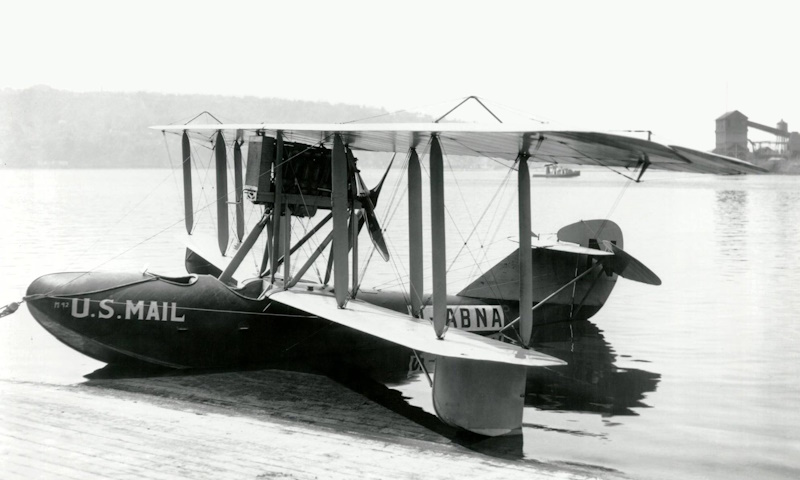
The B-1 was originally powered by a Hall-Scott L-6 6-cylinder water-cooled inline engine with 150 kW (200 HP), driving a four-bladed fixed-pitch prop. It had a secondary open cockpit just in front of the wing for two passengers. The B-1 had an upper wingspan of 15.32 meters (50 feet 3 inches), a length of 9.53 meters (31 feet 3 inches), an empty weight of 1,090 kilograms (2,400 pounds), a cruise speed of 128 KPH (80 MPH / 70 KT), and a range of 640 kilometers (400 miles / 350 NMI). Only one was built, being used for mail delivery between Seattle and northward destinations on the Pacific coast through most of the 1920s. It was eventually re-engined with a Liberty vee-12 water-cooled inline engine with 300 kW (400 HP). It has survived as a museum exhibit in Seattle.
From 1928, Boeing built two examples of a follow-on flying boat, the "Model 6D / B-1D". It was configurationally very much like the B-1, though it was effectively a new-design aircraft, visible differences being a shorter wingspan, an enclosed cockpit for a pilot and three passengers, plus an air-cooled radial engine -- a 9-cylinder Wright J-5F with 160 kW (220 HP), driving a two-bladed fixed-pitch propeller. The B-1D had an empty weight slightly more than that of the B-1.
The two B-1Ds were then supposed to be followed by ten "B-1E" flying boats -- changes including a reinforced airframe and a much more powerful Pratt & Whitney R-1340 air-cooled radial with 310 kW (410 HP). However, as best it can be sorted out, only five B-1Es were built, with three more built as "Model 204" machines, being the same as the B-1E but with a redesigned interior for a pilot and four passengers. One of the Model 204s was completed by another builder while another had dual controls, being labeled "Model 204A", and becoming a personal mount for Bill Boeing. The story is confusing, some sources hinting that the second B-1D was converted or updated to B-1E configuration. It is not clear what happened to the B-1Ds and B-1Es.
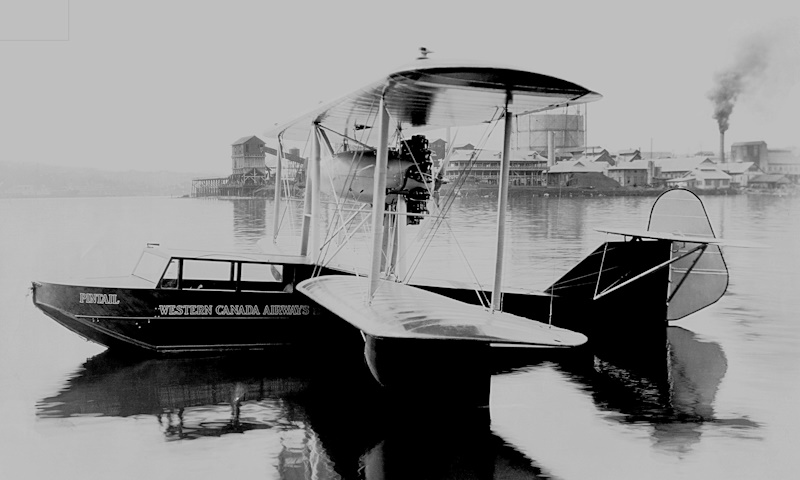
* In the meantime, Boeing built a much bigger flying boat, the "Model 50", for the US Navy, which designated it "XPB-1", with initial flight in August 1925. It was built in response to a 1924 contract from the US Naval Aircraft Factory (NAF), a government organization set up in World War I to ensure that the US could obtain the aircraft it needed. The general layout was provided by the NAF, with Boeing doing the detail design and construction of the single aircraft specified in the contract. Initial flight of the XPB-1 was in August 1925.
As it emerged, the XPB-1 looked like a scaled-up B-1, being an open-cockpit biplane flying boat with fixed floats, though it differed significantly in having mixed metal-wood construction. It also had twin engines, in the form of Packard 2A-2500 water-cooled vee-12 engines providing 600 kW (800 HP) each, driving four-bladed fixed-pitch wooden propellers. The engines were mounted between the wings, in a tandem "push-me-pull-you" arrangement.
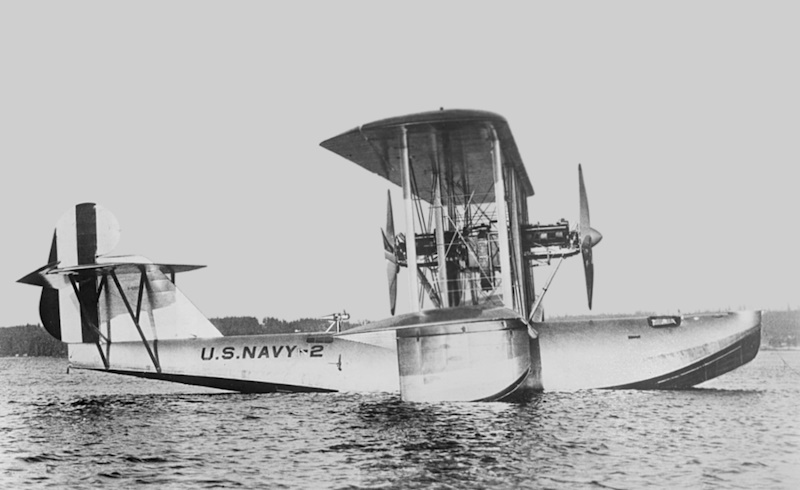
Length was 18.1 meters (59 feet 4 inches), wingspan was 26.7 meters (87 feet 6 inches), and empty weight was 5,240 kilograms (11,550 pounds) -- almost five times as much as the B-1. It had open gun positions for three 7.62-millimeter Browning machine guns on flexible mounts -- one on the nose, one on each side of the rear fuselage. It was designed for long range, specifically the ability to fly between San Francisco and Hawaii, meaning 4,000 kilometers (2,500 miles / 2,250 nautical miles). It never actually made the flight. In 1928, the NAF refitted the XPB-1 with twin Pratt & Whitney R-1690 Hornet 9-cylinder radial engines providing 370 kW (500 HP) each, to be redesignated "XPB-2". What happened to it after that is not clear; it effectively disappeared.
* The most successful Boeing flying boat, the Model 314 Clipper, grew out of a Pan Am request for a next-generation flying boat for the trans-Pacific route, Boeing's offering was selected, with a contract for six machines awarded in 1936. The first flight of the Clipper was on 7 June 1938, with Edmund T. "Eddie" Allen at the controls. Introduction to service in 1939.
The Boeing 314 used the wing of the one-off Boeing XB-15 bomber, the ancestor of the famous B-17. The Boeing Clipper had a general configuration much like that of the VS-44: high-wing flying boat with no wing bracing and four engines. It differed significantly in eliminating wingtip floats and using "sea wings" -- short lower "wings" or sponsons that served as stabilizing floats. It also had triple tailfins -- though it started out with one, which gave insufficient yaw control.
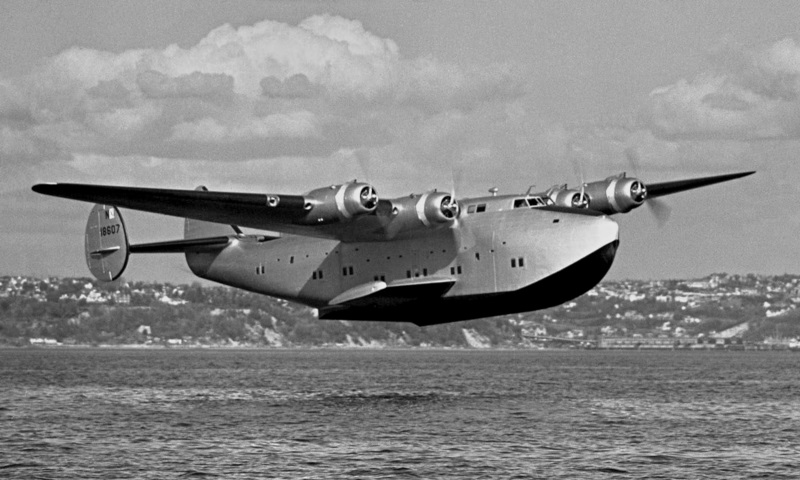
The Model 314 was powered by Wright 709C-14AC1 Twin Cyclone 14-cylinder two-row air-cooled radial piston engines with 1,100 kW (1,500 HP) each, driving 3-bladed Hamilton Standard variable-pitch props. It had a fuel capacity of 20,470 liters (5,408 US gallons) in wing and sponson tanks. It had luxury accommodations -- with a crew of 11, including two cabin stewards, and capacity for 68 day passengers, or 36 passengers in a sleeper configuration. Pan Am ordered a second batch of six aircraft with the designation of "Model 314A", featuring more powerful Twin Cyclones with 1,200 kW (1,600 HP) each, 4,500 liters (1,200 US gallons) more fuel, and carriage of up to 77 day passengers.
___________________________________________________________________
BOEING MODEL 314A:
___________________________________________________________________
wingspan:
46 meters (152 feet)
wing area:
266.3 sq_meters (2,867 sq_feet)
length:
32 meters (106 feet 3 inches)
height:
6.21 meters (20 feet 4 inches)
empty weight:
21,955 kilograms (48,400 pounds)
operating weight:
38,100 kilograms (84,000 pounds)
max speed:
340 KPH (210 MPH / 180 KT)
cruise speed:
305 KPH (190 MPH / 165 KT)
service ceiling:
5,975 meters (19,600 feet)
range:
5,930 kilometers (4,900 miles / 3,200 NMI)
___________________________________________________________________
A flight on a Pan Am Clipper was time-consuming, by modern standards; it took six days to fly from San Francisco to Hong Kong, with fueling stops at Hawaii and other Pacific islands in between. It was expensive, effectively only for the rich; they were given high-class accommodations, with professional chefs making meals for them.
War tensions resulted in Pan Am arranging for the British Overseas Aircraft Corporation (BOAC) to buy the last three of the six Model 314As -- which proved politically controversial in the UK, since the purchase was made without formal government approval. Commercial passenger service for the Clippers ended after Pearl Harbor; one, the PACIFIC CLIPPER, was heading for New Zealand when the news of the attack came in by radio, with the flying boat ending up going back to the USA via the Atlantic, arriving in New York. It was the first commercial round-the-world flight in history.
Pan Am's Clippers were impressed into military service, being used to ferry personnel and equipment across the Atlantic and the Pacific. They were actually flown by experienced Pan Am crews under military contract. The Army got four, giving them the designation of "C-98", while the Navy got five, simply calling them "B314s". US President Franklin Roosevelt flew on a Boeing Clipper to the Casablanca Conference in 1943.
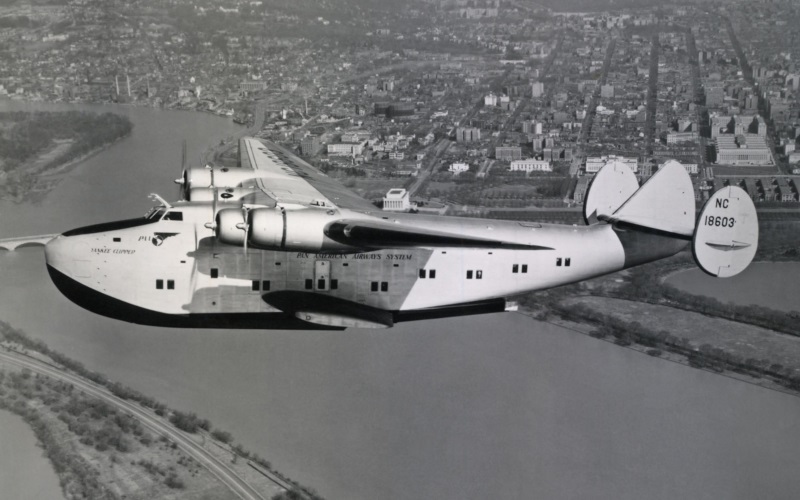
Three Boeing Clippers were lost in accidents, a 1943 crash in Portugal killing 24 passengers and crew. Some of the Clippers returned to Pan Am service after the war, but the era of Flying Clippers was over. Their primary advantage was that they didn't need airports, but the war resulted in the construction of a global network of airfields, supporting landplanes that were less compromised in design and easier to operate. A Boeing Clipper pilot said:
BEGIN_QUOTE:
We were indeed glad to change to DC-4s, and I argued daily for eliminating all flying boats. The landplanes were much safer. No one in the operations department ... had any idea of the hazards of flying boat operations. The main problem now was lack of the very high level of experience and competence required of seaplane pilots.
END_QUOTE
Pan Am sold off their Boeing Clippers in 1946, with BOAC getting rid of their Model 314s in 1948. By 1951, they had all been scrapped or scuttled. There's been talk of raising some of the scuttled machines for restoration, but so far it's been just talk. There is a full-size replica of a Boeing 314 at the Foynes Flying Boat Museum in County Limerick, Ireland, with truncated wings but a detailed interior.
* Boeing built one, specifically one, more flying boat after the Model 314 -- the Model 344 Sea Ranger. It grew out of a US Navy requirement for a long-range flying boat, with a contract for 57 aircraft being issued to Boeing in June 1940. The initial prototype of the "Experimental Patrol Bomber, Boeing (XPBB) 1" performed its first flight on 9 July 1942.
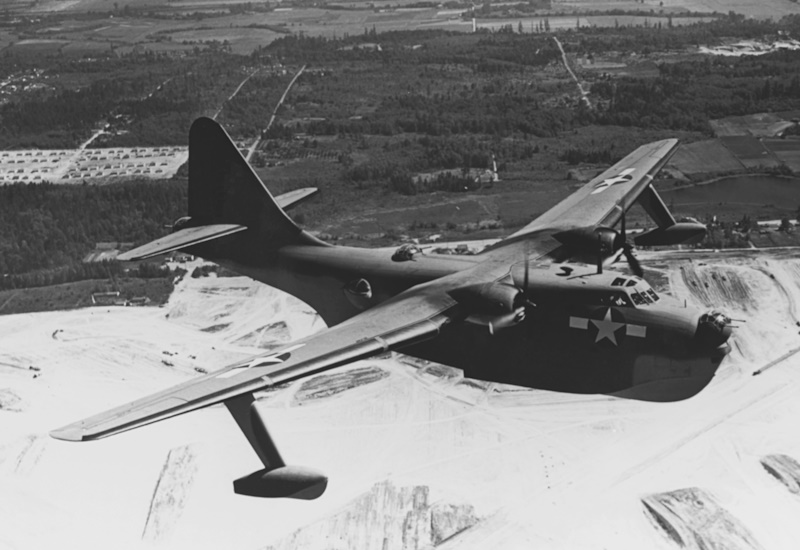
As it emerged, the XPBB-1 was a large twin-engine flying boat, with a general configuration like that of the contemporary Martin PBM Mariner. It had a stepped boat hull and fixed floats; it was not an amphibian and could not land on a runway. It featured a long, high-mounted straight wing -- it appears derived from that of the B-29 Superfortress -- each wing featuring a Wright R-3350 Duplex Cyclone radial engine with 1,175 kW (2,300 HP), driving a three-bladed Curtiss Electric propeller.
___________________________________________________________________
BOEING MODEL 344 / XPBB-1 SEA RANGER:
___________________________________________________________________
wingspan:
42.6 meters (139 feet 9 inches)
wing area:
169.7 sq_meters (1,826 sq_feet)
length:
28.9 meters (94 feet 9 inches)
height:
10.42 meters (34 feet 2 inches)
empty weight:
18,880 kilograms (41,530 pounds)
max take-off weight:
45,970 kilograms (101,100 pounds)
max speed:
345 KPH (215 MPH / 185 KT)
cruise speed:
255 KPH (160 MPH / 140 KT)
service ceiling:
6,830 meters (22,400 feet)
ferry range:
10,000 kilometers (6,300 miles / 5,500 NMI)
operational range:
6,835 kilometers (4,250 miles / 3,690 NMI)
___________________________________________________________________
There were power turrets in the nose, on the back behind the wings, and in the tail, each with twin 12.7-millimeter (0.50-caliber) Browning machine guns; there was also a gun blister with a single Browning on each side of the rear fuselage. There were five weapons bays on each wing inboard of the engine; maximum warload weight was 9,070 kilograms (20,000 pounds). A torpedo could alternatively be mounted under each inboard wing section. Normal crew was ten.
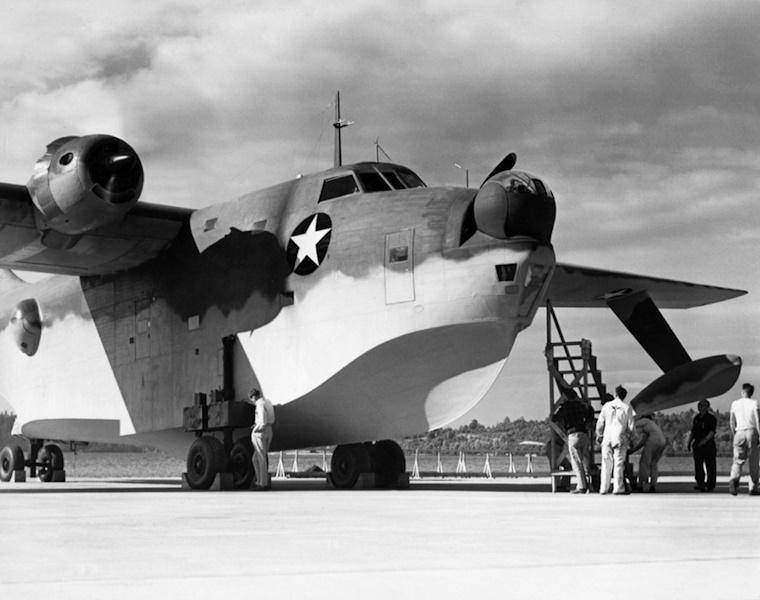
The aircrew sat in a short upper deck, with the lower deck being divided into seven watertight compartments. Along with the munitions bays, the wing center section contained integral fuel tanks, with main and auxiliary tanks in the outer wings. The auxiliary tanks were only to be used for long-range ferry flights; when filled, the Sea Ranger could only get into the air with jet-assisted take-off (JATO) rockets. Originally, the NAF was to build a big barge catapult for that action, but JATO proved a more realistic solution.
The Sea Ranger had been canceled even before its first flight; land-based aircraft could perform long-range oceanic patrols. Since flying boats couldn't land on the open seas in any high sea state, they didn't have much advantage over land-based aircraft anyway. The XPBB-1 remained in service for test and trials until 1947, when it was retired and later scrapped. Flying boats do linger, but primarily as fire-fighters -- relatively small aircraft that land on lakes to tank up with water.
BACK_TO_TOP* Sources were mostly an online scavenger hunt. These aircraft are not well-documented.
* Illustrations credits:
* Revision history:
v1.0.0 / 01 may 24 (+)BACK_TO_TOP
